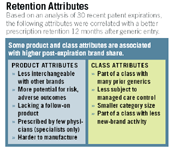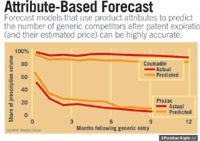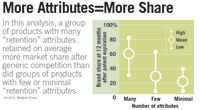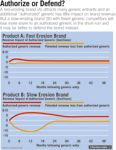Your Patent is About to Expire: What Now?
Sometimes the loss of revenue from a branded drug can outweigh the royalty stream from an authorized generic.
When generic versions of Lilly's antidepressant Prozac (fluoxetine) were introduced in 2001, Prozac's volume fell precipitously—losing 73 percent of its share of new prescriptions within two weeks. Although that may be the most well -known example of the impact of generics, the Federal Trade Commission reports that between 1984 (when Congress passed the Hatch-Waxman Act) and 2002, generics' prescription share has risen from 19 to 47 percent. Today, the figure is widely reported to be more than 50 percent. Based on review of recent patent expiration data, such rapid losses of revenue for brand owners appear to be more common. Generic companies are stronger and more sophisticated, and payers are more effective in their efforts to influence the way prescriptions are written and filled. Review of data from recent expirations suggests that pharmaceutical brands are losing more share, on average, in the first 12 months after generic entry today than they did several years ago. Next year, products with combined US sales totaling more than $15 billion will face generic competition for the first time. (See "Soon to Expire,".) For brand companies, the difference between a more rapid and less rapid drop in product share could translate into a revenue difference of several hundred million dollars.

Soon to Expire: During the next two years, US market will experience the patent expiration of a group of products with more than $ 15 billion in revenues.
Predict the Blow
Not surprisingly, brand companies have aggressively pursued a variety of lifecycle-management tactics. Transferring brand equity (and prescriptions) to a follow-on product, reformulation, or new delivery system, can sustain the franchise. Switching the Rx brand to an over-the-counter product, when possible, is another way to retain revenue.
Despite these tactics—and the great effort devoted to them—the bulk of the expiring brand revenues will at some point give way to generics. The question for a pharma company is: How quickly? And a key corollary question is: If a company can predict how quickly brand revenues will erode, are there different tactics it should use depending on the rate of decline?
Pharma brands are not all equal. The rapid erosion of Prozac's share can be contrasted with that of Intal (cromolyn), an asthma treatment, which fared much better. (See "Case Study Comparison.") Some products have obvious attributes that make rapid switching less likely. In this case, Intal has a complex metered-dose inhalant system that makes it more difficult for generics to copy and manufacture.

Case Study Comparison: Prozac and Intal demonstrate how brands can experience different market share patterns after patent expiration
The challenge, though, is not just to recognize a brand's potential loss to generics but also to forecast it effectively. Companies must account for the timing of generic launches as well as other circumstances that may affect postexpiration performance. Investment decisions—continued brand promotion or a clinical trial for a new formulation—depend on a reliable forecast. As generics enter, brand teams must grapple with planning and forecasting decisions that differ from those encountered during the patent's life and may include strategic options such as the possibility of an authorized generic.
Attributes Affect Share
Determining a brand's intrinsic potential for share retention is critical to forming that strategy. Brand managers must pinpoint the key factors associated with share retention and figure out how to make the best estimates of a brand's potential.
Analysis Group research indicates there are several product and therapeutic class attributes that are most strongly associated with share retention. They can be grouped into two categories: product and class. (See "Retention Attributes.")

Retention Attributes: Based on an analysis of 30 recent patent expiration, the following attributes were correlated with a better prescription retention 12 months after generic entry.
Product attributes. Generally, products that are more difficult to manufacture have higher potential for share retention because there will be fewer generic entrants. This phenomenon has historically applied to certain advanced delivery systems—the osmotic pump technology in Procardia XL (nifedipine), for example—and it is likely to come into play more frequently during the next few years as biologic injectables, such as Epogen/Procrit (erythropeitin), begin to lose exclusivity.
Another product attribute associated with share retention is the complexity or risk associated with administering the drug. Physicians are more conservative, payers less demanding, and generic entrants less aggressive about products with high risks or challenging titration (concentration) issues. The blood-thinning drug Coumadin (warfarin) has had few generic competitors and has sustained high sales for many years, in part because of the risks associated with its narrow therapeutic index.

Attribute-Based Forecast: Forecast models that use product attributes to predict the number of generic competitors after patent expiration (and their estimated price) can be highly accurate.
One circumstance meriting special attention is whether the manufacturer has developed or licensed a follow-on product in the class. Follow-ons and OTC options are typically considered long before the patent expires and are crucial in determining the brand's potential. In most cases, a brand's share erosion is accelerated by the introduction of a new brand by the same manufacturer, for example, AstraZeneca's launch of Nexium (esomeprazole) to follow Prilosec (omeprazole).
Class attributes. The therapeutic class is also critical to the brand's potential for retaining share. For instance, if there has already been a significant number of generic entrants to a class, companies can expect a weak effect from a new generic, both on the brand and the class overall, because some degree of shifting to generics may have already occurred.
Category conditions, in which a new brand or therapeutic class is about to enter the market, can override product attributes that might help retain share. The post-expiration share loss experienced by Pepcid (famotidine), a leading H2 agonist for treating acid reflux disease, was accelerated in part by the entry of proton pump inhibitors into the category.
In addition, the prescribing environment—including managed-care benefit structures (patient copay, prior authorization, and step edits), state Medicaid preferred drug lists (PDLs), and Medicare coverage/reimbursement—is constantly changing. Modeling these dynamics is an essential step in defining a product's optimal postexpiration strategy.
Forecast Factors
Another Analysis Group finding is that the more "retention" attributes a product has, the more prescription share it retains in the face of generic competition. (See "More Attributes=More Share.") The research also shows that brand managers can use these attributes to create powerful multivariate models that estimate brand share and allow scenario analysis of the brand's strategic options. Such models can be en- hanced if the brand team is able to approximate the number of generic entrants by determining the number of abbreviated new drug applications that have been filed for the compound.
The graphic "Attribute-Based Forecast" uses an Analysis Group model to demonstrate the estimated and actual share erosion of two products: one that has retained significant share (Coumadin) and one that has seen substantial share erosion (Prozac). In a second, hypothetical example, this model would suggest that Lovenox (enoxoparin), which poses many of the retention attributes, will be able to hold on to substantially more share than Cefzil (cefprozil), which has none.

More Attributes=More Share
As with the share impact, the pattern of generic prices after patent expiration can be predicted as a function of the compound's product and class attributes. In response, brand managers can adjust brand prices, and the choices made for brands have varied widely. Two obvious strategies are: (1) follow the generic price (downward) and attempt to retain share through existing relationships with distributors and possibly through rebates to selected managed care plans; or (2) maintain or increase price while share erodes by maintaining margin on remaining sales. Evidence suggests that although brand price can affect market share after patent expiration for products with retention attributes, for others the relationship is weaker, and pricing at parity with the generics to retain share can backfire. Such was the case with Eli Lilly's heart failure therapy Dobutrex (dobutamine), which dropped its price in an attempt to retain share but instead lost as much share as would be expected with a steady price.
Another important factor to consider is the interaction of generics with other brands and other therapeutic classes. Generics often expand a molecule's share of the class by drawing market share from other brand-name agents in the class or by drawing new, untreated patients to the class. Generics also may expand the class share of a broader therapeutic category. For example, generic ACE-inhibitors could expand the ACE-inhibitor share of the antihypertensive category. Knowing the degree to which a generic entrant could expand the molecule or class, versus gaining share from the brand, is essential to determining brand potential. Analyzing data from prior patent expirations by looking only at the share of molecule can result in underestimating the brand's true potential.
Authorize or Not?
Among the set of decisions managers must make as they determine the right path for a brand losing exclusivity, there are two critical choices:
- whether to participate in the generic arena with an authorized generic product
- how aggressively—if at all—to support the brand with investments aimed at differentiating it from generic competitors (pricing, promotion level/mix, and clinical studies).
The authorized generic is a recent development that is generating some debate. It is negotiated when the manufacturer of a drug nearing patent expiry contracts with a generic company to sell an "authorized" version of the molecule, in some cases actually supplying the product to the generic company. Particularly in those instances in which a legal challenge (under paragraph IV of the Hatch-Waxman Act) creates the potential for the first generic to enjoy a 180-day exclusivity period, brand owners have begun to use this "join rather than fight" approach.
In recent months, several brand-name pharma companies, including Bristol-Myers Squibb, GlaxoSmithKline, Johnson & Johnson, and Pfizer, have drawn a great deal of attention for their launched or planned authorized generics. While regulatory opinion still evolves and long-term results have yet to be observed, evaluation of an early case offers useful insights.
GlaxoSmithKline contracted with Par to sell a generic version of Paxil (paroxetine). In September 2003, Par launched its generic simultaneously in the market with a generic from Apotex, the company that had challenged GSK's patent under paragraph IV and been awarded a 180-day exclusivity period. By launching concurrently with Apotex, Par gained access to the higher generic prices of the first 180 days, although its presence may have pushed the prevailing generic price lower than it would have been if Apotex's version had been alone during that period. In addition, Par gained the opportunity to establish contracts and distribution with pharmacies that could help it sustain share after other generics entered the market.
The arrangement clearly benefited Par. Apotex, by contrast, was forced to share what could have been a period of exclusivity. Not surprisingly, manufacturers in Apotex's position have objected to these arrangements. To date this year, generics companies have filed four citizen's petitions with FDA regarding authorized generics, all of which were rejected. In its most recent ruling, FDA stated that the entry of authorized generics and the resulting lower drug prices benefit US consumers. This situation will continue to evolve but regulatory sentiment at this time favors the benefit to consumers over any losses of generic exclusivity.
As for GlaxoSmithKline, depending on the terms of its contract with Par, the authorized generic appears to give GSK a royalty stream from generic paroxetine that will supplement the postexpiration brand revenues from Paxil. But are there circumstances in which the loss of revenue from the brand name drug would outweigh the royalty stream from the authorized generic? Consider two hypothetical cases. Product A represents a fast-eroding blockbuster, while Product B is a comparably sized but slower-eroding product attracting fewer generics. Both would benefit from the royalty stream of an authorized generic. (See "Authorize or Defend?".) Product B's royalty stream, however, would be higher because of the presence of fewer generic companies. But managers must also evaluate incremental erosion of the brand revenue. In a case in which many generics will enter and the branded drug share will erode quickly (A), the addition of one more generic—the authorized one—will not typically erode the brand revenue much further. In this case, an authorized generic is likely to be financially favorable.

Authorize or Defend? Product A: Fast Erosion Brand, Product B: Slow Erosion Brand
Product B illustrates a more complicated dynamic. In this case, (with fewer generics and slower erosion) the authorized generic materially affects brand sales. The additional generic and the greater generic price erosion have the effect of increasing total generic share at the expense of the brand. In such circumstances, it may take substantially longer for the authorized generic deal to break even for the brand owner. Or, depending on the contract terms, it may not be worthwhile. In addition, in cases where an authorized generic is warranted, the most effective brand pricing strategy is likely to involve maintaining or increasing the price.
Before striking an authorized generic deal, companies must take into account all the circumstances surrounding the patent expiration. Following are the three most important factors that will lead to the success of an authorized generic:
- The product has a predominance of attributes associated with fast erosion.
- The product and market are substantial and possess characteristics likely to attract multiple generic entrants.
- The product is able to attract a strong generic licensing partner.
Support the Brand or Not?
In addition to deciding whether to participate in the generic arena, the innovative company must also decide whether to continue investing in the brand. Although the historical norm—and likely the right answer for many products—has been to withdraw all investment from brands at or before the patent expiration time, the decision should be carefully considered. When there are product and class attributes that correlate with high share retention, some amount of continued investment may be warranted.
The case of Fisons' Intal provides one example in which continued investment was likely merited. Intal is a mast cell stabilizer used primarily for asthma. The delivery mechanism was not a widely diffused technology at the time (1995), and relatively few companies were able to reproduce the product. The first generic entrant did not use an identical delivery technology, and Fisons invested in communicating these differences. Intal maintained more than 40 percent share 12 months after patent expiration and, as late as 2000, it was still generating significant revenue.
There are other examples of manufacturers successfully differentiating and maintaining a branded product after patent expiration. Coumadin is a well-known example. Armed with several intrinsic attributes associated with share retention (mortality risk, dosing concerns, few prescribers) and supported by studies, DuPont, and then BMS, continued to promote the product and communicate the data to agencies and payers. Although such circumstances are relatively rare, there will be more cases in years to come, particularly as biologics lose exclusivity.
In the arena of more typical products, the question is likely to be whether any form of investment, such as a small study on therapeutic equivalence, should be undertaken. For example, if a delay with a planned follow-on creates a substantial gap between the original product's expiration and the launch of its successor, the brand owner needs to consider the merits of remaining engaged in the category during that period.
The variance in appropriate responses is illustrated by examining the promotional activity in recent patent expirations. Three patterns emerge. (See "Patterns of Investment,".) The first, showing a sharp drop in activity beginning well before the first generic competitor enters, is typical but hardly universal. The other patterns are the burst of late-life activity and the sustained investment associated with a product like Coumadin.

Patterns of Investment: Rapid pull back, Burst of late-life activity, Sustained investment
An effective model for postexpiration performance should consider the effects of continuing brand promotion (after accounting for the attributes and category dynamics). Such a model can be highly valuable for a wide range of products, helping to assess underlying potential and customer responsiveness.
The Big Picture
More active, systematic management of brands facing loss of patent protection is essential for pharma companies. As more high-revenue brands, including biologics, lose exclusivity and as generic companies continue to grow in sophistication and strength, brand owners should look beyond traditional lifecycle management to ensure that postexpiration options are fully evaluated.
Understanding the intrinsic potential of a brand is an essential complement to the pursuit of the traditional lifecycle options of follow-on or reformulated compounds. A systematic, attribute-based approach to simulating product performance allows more informed consideration of appropriate options—both in terms of continued brand support and generic participation. This fuller picture should be the goal of all brand managers as their products advance toward inevitable patent expiration.
Edward Tuttle and Andrew Parece are managing principals, and Anne Hector is a vice-president of Analysis Group (www.analysisgroup.com), an economics, financial, and strategy consulting firm. The views expressed in the article are those of the authors and do not necessarily reflect positions of the firm or its affiliates.
The Misinformation Maze: Navigating Public Health in the Digital Age
March 11th 2025Jennifer Butler, chief commercial officer of Pleio, discusses misinformation's threat to public health, where patients are turning for trustworthy health information, the industry's pivot to peer-to-patient strategies to educate patients, and more.
Navigating Distrust: Pharma in the Age of Social Media
February 18th 2025Ian Baer, Founder and CEO of Sooth, discusses how the growing distrust in social media will impact industry marketing strategies and the relationships between pharmaceutical companies and the patients they aim to serve. He also explains dark social, how to combat misinformation, closing the trust gap, and more.
